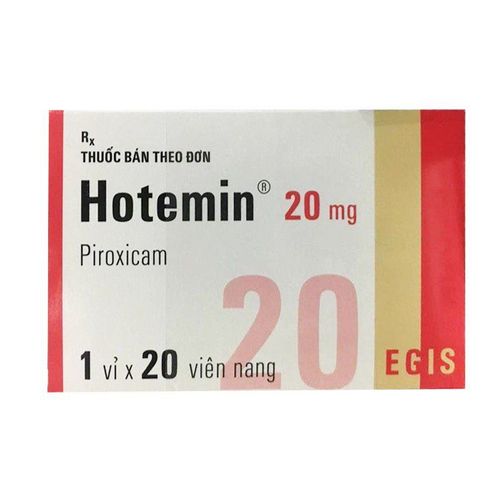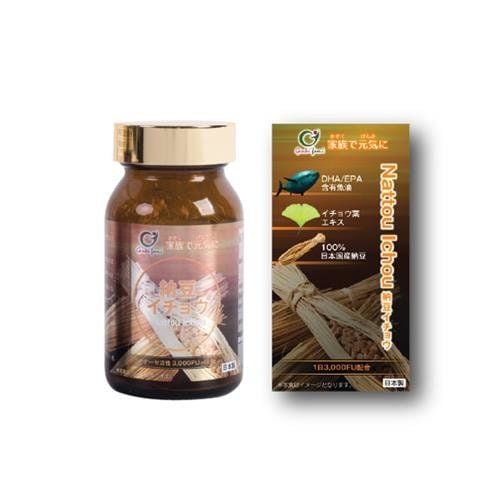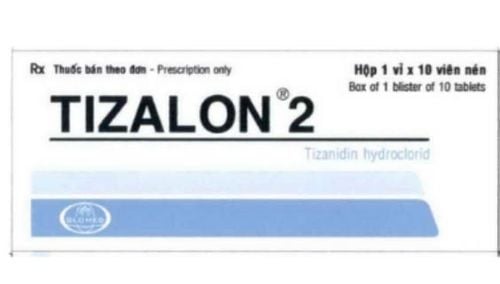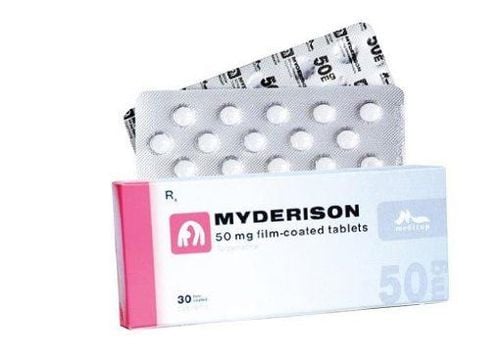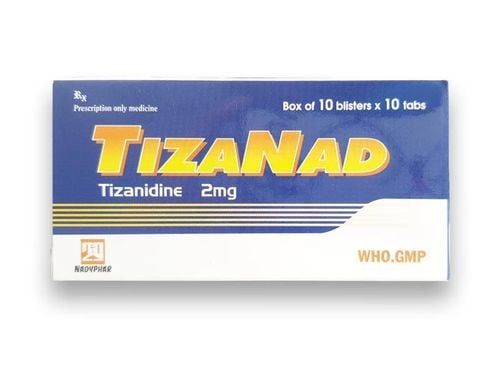This is an automatically translated article.
Zanastad drug has the main ingredient is Tizanidin 2 mg, belongs to the group of muscle relaxants commonly used in the treatment of muscle contractions due to dysfunction, posture or neurological disorders. The necessary information about the composition, uses, dosage and side effects of Zanastad medicine will help patients and their families achieve the best treatment effect.
1. What is Zanastad?
Zanastad drug is prepared under tablets, with the main ingredients including:
Active ingredient: Tizanidin content 2 mg. Excipients: Microcrystalline cellulose, Lactose monohydrate, Pregelatinized starch, Stearic acid, Colloidal anhydrous silica just enough for 1 tablet 2 mg. Mechanism of action
Active ingredient Tizanidin is an α2 adrenergic agonist, which reduces muscle spasticity through increased presynaptic inhibition of motor neurons at α2 adrenergic receptors of the upper central nervous system. spinal cord and spinal cord. The result of this process is reduced excitability of motor neurons in the spinal cord. Thereby reducing muscle contractions, reducing tremors without excessive muscle weakness, and improving active muscle movements. In addition, the active ingredient Tizanidine also has the effect of lowering blood pressure through binding to the Imidazoline receptor, but this effect is often less effective.
2. What does Zanastad do?
What does Zanastad do? Zanastad is indicated for the treatment of the following cases:Muscle spasm with pain due to spinal dysfunction or posture such as torticollis, pain around the shoulder, low back pain, pain after surgery hip osteoarthritis, herniated disc taste. Spasticity caused by motor neuron disorders such as multiple sclerosis, cerebrovascular accident, traumatic brain injury, cerebral palsy, degenerative spondylolisthesis, chronic spinal cord disease.
3. Contraindications of the drug Zanastad
Contraindications of Zanastad drug in the following cases:
Hypersensitivity to any component of Zanastad drug. History of allergy to other medicines with the active ingredient Tizanidine. Severe liver failure. People who are being treated with fluvoxamine or ciprofloxacin.
4. Dosage and how to use Zanastad
Adults
Muscle spasticity: Initial dose: Take 1 tablet (2 mg)/time x 3 times/day. Dose increase: Take 3 tablets (6 mg)/time x 3-4 times/day. Increase dose by 1 tablet (2 mg) every 3 to 4 days depending on patient response. The maximum dose should not exceed 18 tablets (36 mg)/day. Pain caused by muscle contractions: Take 1-2 tablets (2-4 mg)/time x 3 times/day Children: Not recommended because safety has not been determined.
Patients with renal failure
Adjust dose based on Creatinine clearance (CrCl)
CrCl dose < 25 ml/min: Take 1 tablet (2 mg)/time x 1 time/day. Increase dose by no more than 1 tablet (2 mg) once daily depending on patient response.
5. Notes when using Zanastad
5.1.Side effects encountered when using Zanastad Treatment with Zanastad in high doses or for a long time, can cause side effects such as:
Common: Neurological symptoms such as fever, fatigue, dizziness facial, somnolence, somnolence, depression, anxiety, hallucinations, paresthesia. Skin symptoms such as rash, skin ulcers, sweating. Symptoms of digestive disorders such as dry mouth, loss of appetite, nausea, vomiting, indigestion, diarrhea. Musculoskeletal symptoms such as back pain, myasthenia gravis. Uncommon: Central nervous system symptoms such as confusion, dizziness, lightheadedness, dreams, tremors, convulsions, paralysis, migraine, neuralgia, emotionality, personality disorder. Sinusitis or bronchitis. Cardiovascular symptoms such as arrhythmia, vasodilation, orthostatic hypotension. Gastrointestinal symptoms such as difficulty swallowing, flatulence, gastrointestinal bleeding, hepatitis, gallstones, black stools. Symptoms of urogenital system such as urinary tract infection, cystitis, menorrhagia. Biochemical and metabolic disorders such as edema, weight loss, hypothyroidism, anemia, hematoma, decreased or increased white blood cell count, hypercholesterolemia, hyperlipidemia. Sensory disturbances such as eye pain, glaucoma, conjunctivitis, optic neuritis, ear pain, tinnitus, deafness, otitis media a . Arthritis, pathological fracture. Other symptoms such as allergies, urticaria, itching, severe may anaphylaxis, dry skin, acne, hair loss, cellulitis. Rare: Central nervous system symptoms such as dementia, hemiplegia. Asthma. Cardiovascular symptoms such as angina, coronary disorders, myocardial infarction, heart failure, ventricular extrasystoles, ventricular tachycardia, phlebitis, pulmonary embolism. Gastrointestinal symptoms such as vomiting blood, gastroenteritis, liver tumor, liver damage, intestinal obstruction. Genitourinary system symptoms such as hematuria, increased albuminuria and urinary glucose. Biochemical and metabolic disorders such as hypoproteinemia, respiratory acidosis, hyperglycemia, hypokalemia, hyponatremia, adrenal insufficiency, thrombocytopenia purpura. Sensory disturbances such as iritis, keratitis. Arthritis, pathological fracture. Other symptoms such as Herpes simplex virus infection, Herpes Zoster, peeling skin, skin cancer. The above symptoms will be relieved immediately after stopping the use of Zanastad and are less severe. However, when detecting the above side effects or any other abnormalities after taking Zanastad, the user should promptly notify the treating doctor or immediately go to the medical facility for timely treatment. .
5.2. Notes on the use of Zanastad in subjects Caution when using Zanastad in children and the elderly or people with a history of or are suffering from cardiovascular diseases, severe liver and kidney function impairment, patients with Galactose intolerance, Glucose-Galactose malabsorption or total lactase deficiency. Pregnant women: According to the classification of the US Food and Drug Administration (FDA), active ingredient Tizanidin belongs to group C, the group with evidence of risk on pregnancy. Therefore, use Zanastad in pregnant women only when clearly needed. Lactation: Studies have suggested that Tizanidine may pass into breast milk, because of its lipid-soluble properties. It is recommended that Zanastad be used only when the benefits outweigh the risks. Drivers or workers who operate machinery often experience some side effects such as dizziness, dizziness, drowsiness, visual disturbances when using Zanastad, so it is important to avoid taking the drug right before and during work.
6. Zanastad drug interactions
Interactions with other drugs
Caution should be exercised when Zanastad is used together with antihypertensive drugs, as it may cause excessive hypotension and bradycardia. Zanastad increases the concentration of Phenytoin in the blood. Zanastad increases the time to peak concentration of Paracetamol. The toxicity of Zanastad is increased when co-administered with drugs that prolong the QT interval. Drugs that decrease the clearance of Zanastad: Oral contraceptives. CYP1A2 inhibitors such as Acyclovir. Antiarrhythmic drugs such as Mexiletine, Propafenone, Amiodaron, Verapamil. Quinnolone antibiotics such as Nofloxacin, Ofloxacin, Ciprofloxacin. Ticlopidine Zileuton Above is basic information about ingredients, uses, doses and precautions when using Zanastad. In order to bring about the best treatment effect for themselves and their families, users should carefully read the instructions for use of Zanastad before using, and strictly follow the treatment instructions of the treating doctor.
Follow Vinmec International General Hospital website to get more health, nutrition and beauty information to protect the health of yourself and your loved ones in your family.
Please dial HOTLINE for more information or register for an appointment HERE. Download MyVinmec app to make appointments faster and to manage your bookings easily.





